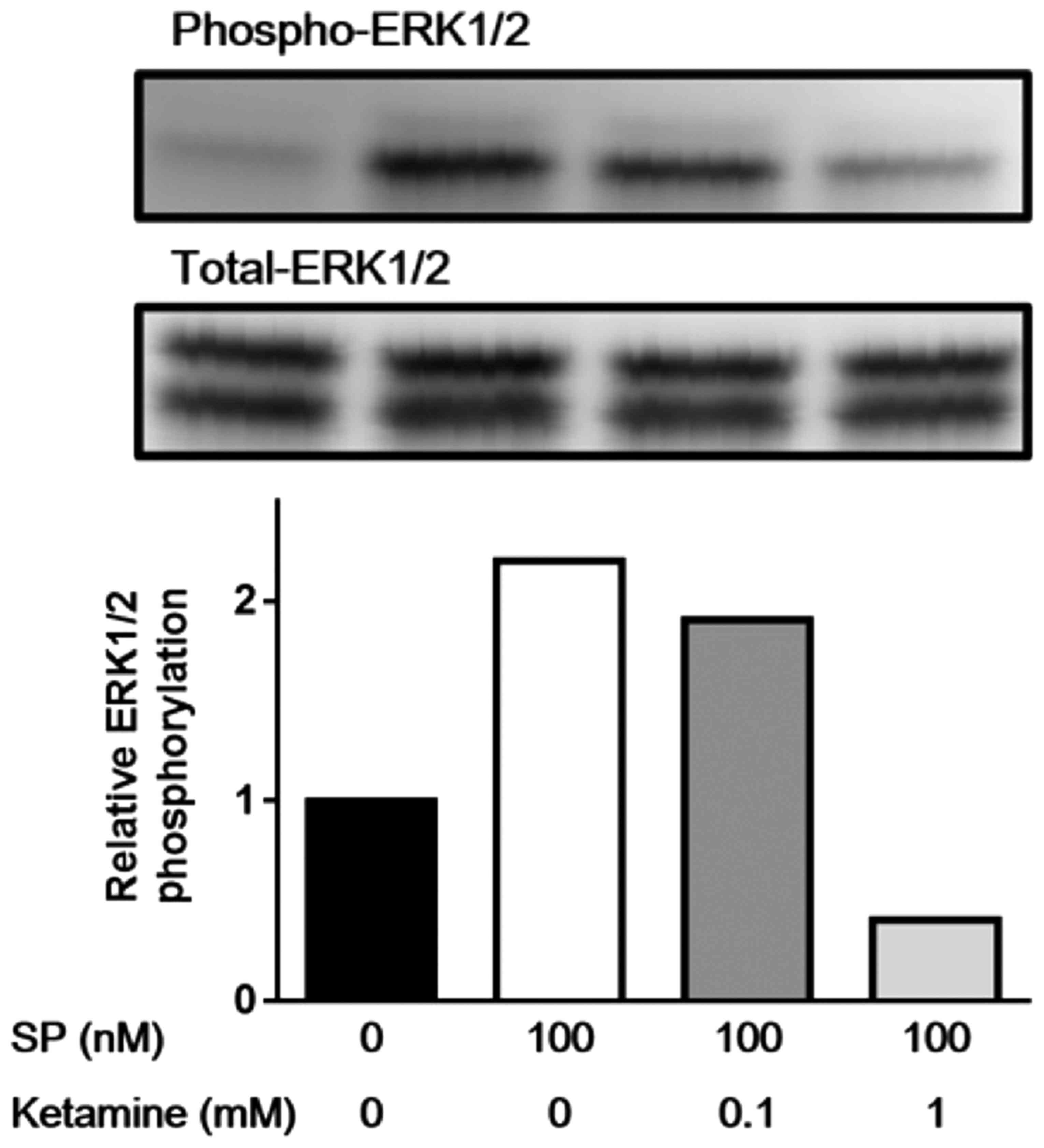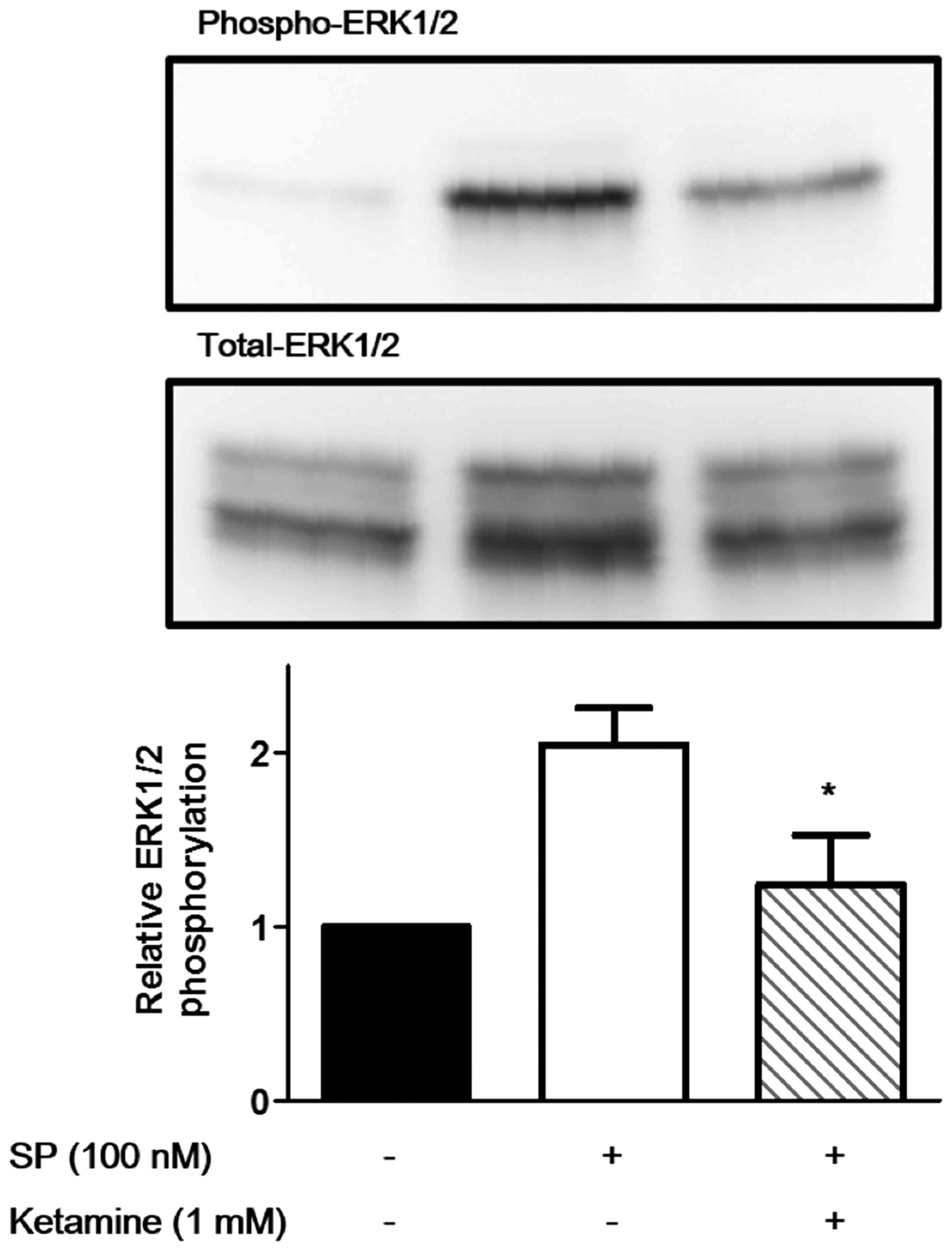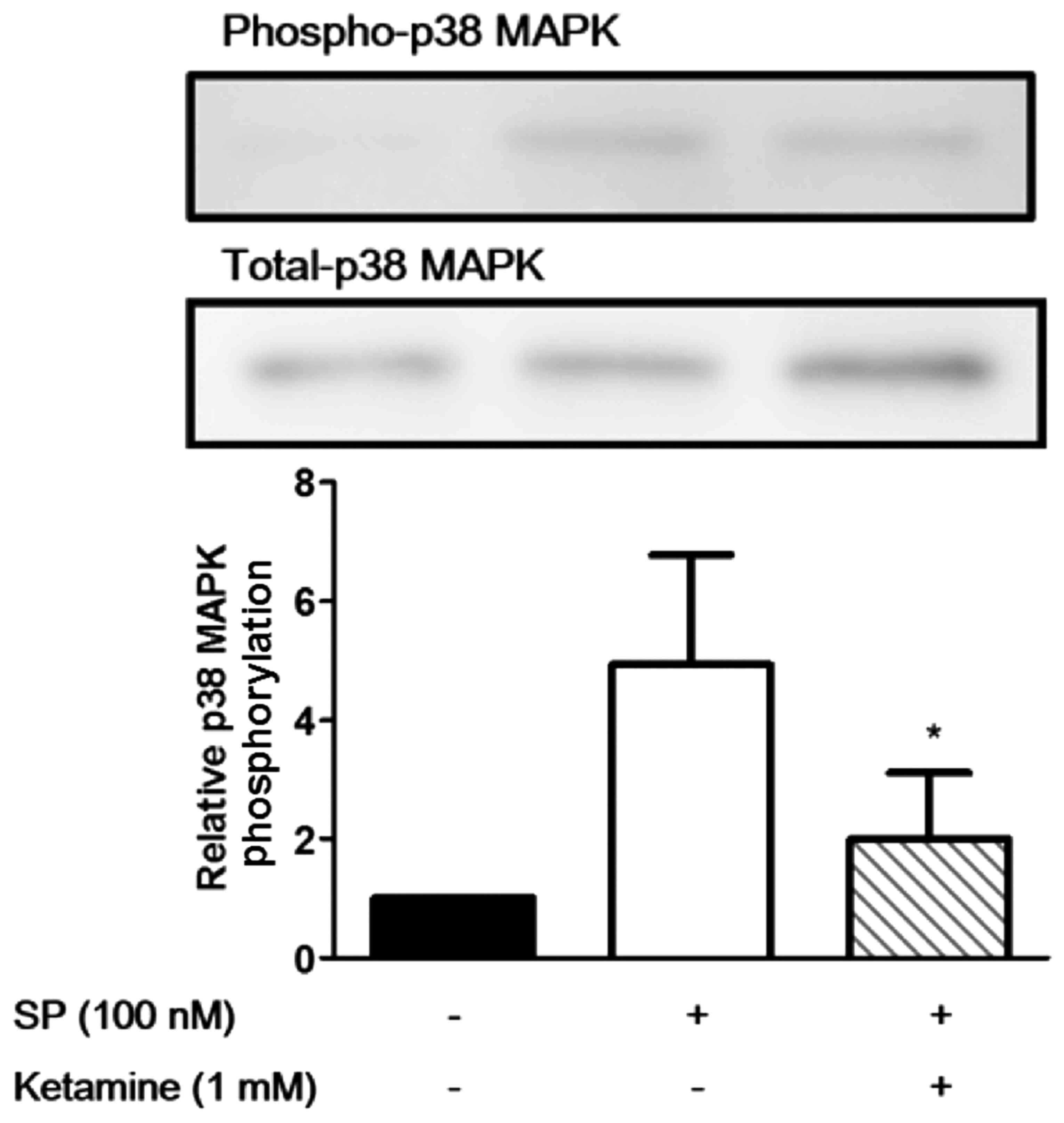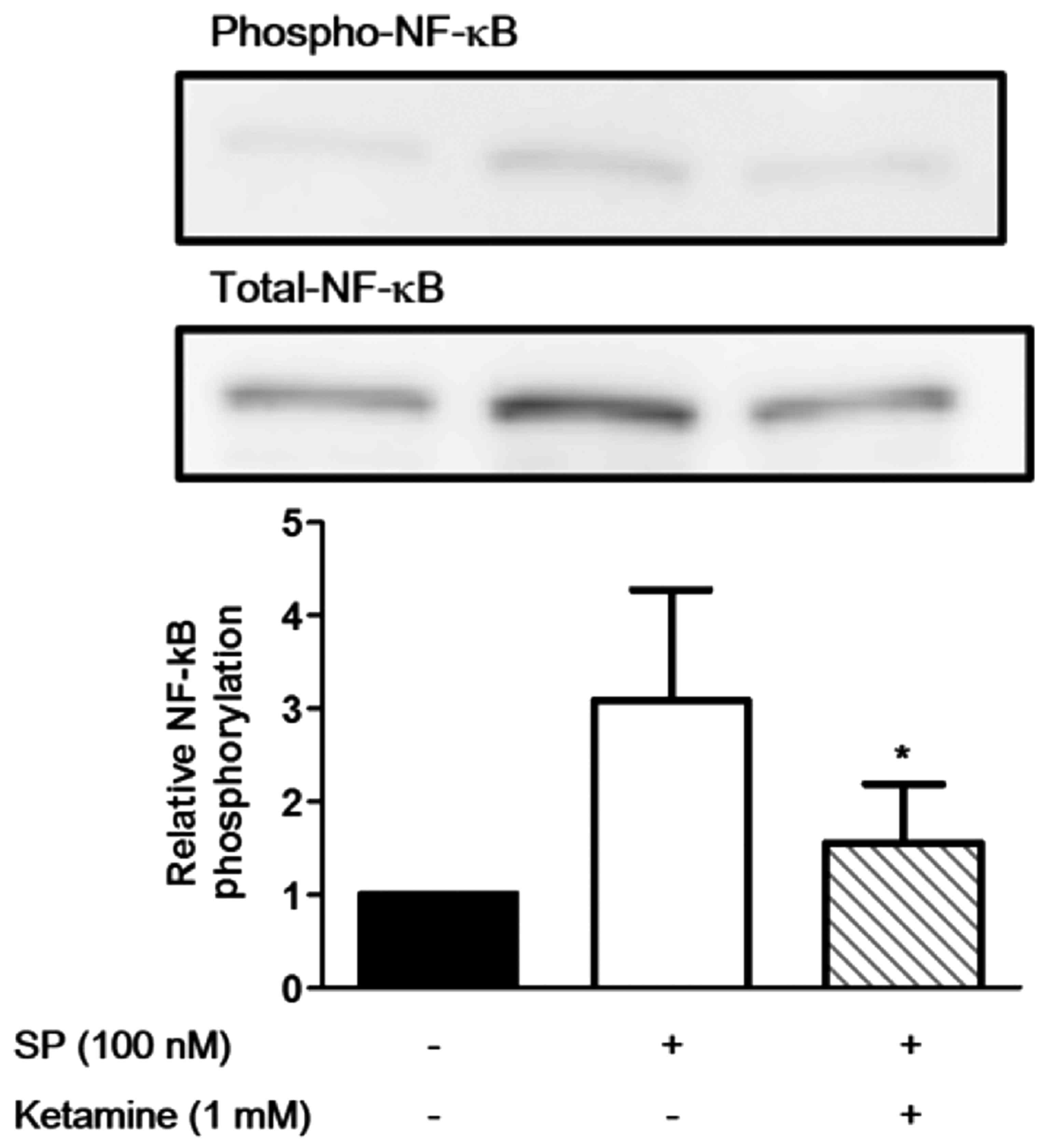Ketamine suppresses the substance P-induced production of IL-6 and IL-8 by human U373MG glioblastoma/astrocytoma cells
- Authors:
- Published online on: February 3, 2017 https://doi.org/10.3892/ijmm.2017.2875
- Pages: 687-692
Abstract
Introduction
The neuropeptide substance P (SP) is an important mediator of neurogenic inflammation within the central and peripheral nervous systems. SP has been implicated in pain, and also plays important roles in cancer (e.g., tumor cell proliferation, anti-apoptotic effects on tumor cells, angiogenesis, tumor cell invasion and metastasis) (1–8). SP is released from primary afferent nociceptors and sympathetic post-ganglionic neurons, and activates neighboring receptors, thereby triggering and spreading activation (6–11). Moreover, SP has been shown to induce the expression of pro-inflammatory cytokines, such as interleukin (IL)-6 and IL-8 (12,13), which are involved in the pathogenesis of several disorders of the human brain (such as multiple sclerosis, dementia complex, and Alzheimer's disease) (14), although it is currently a matter of debate as to whether SP plays a pathogenic or a protective role in these disorders. Previous research has indicated that the activation of an SP receptor [neurokinin-1 receptor (NK-1R)] elicits signals affecting the gene expression of some inflammatory cytokines (13). In addition, it has been reported that nanomolar concentrations of SP potently trigger the activation of nuclear factor-κB (NF-κB), an important transcriptional activator, which regulates the production of various cytokines and other proinflammatory mediators (13).
The mitogen-activated protein kinase (MAPK) family of protein Ser/Thr kinases consists of at least three major subfamilies: i) the p42/44 MAPKs, which are also known as the extracellular signal-regulated kinases (ERKs)1/2; ii) the c-Jun NH2-terminal kinase/stress-activated protein kinases (JNK/SAPKs), including p46 JNK-1 and p54 JNK2; and iii) the p38 MAPK subfamily. MAPKs are activated under conditions of stress in response to a number of extracellular stimuli, including oxidative stress. Among these, the phosphorylation of p38 MAPK is induced in the dorsal horn of the spinal cord and in the dorsal root ganglia following peripheral nerve injury or inflammation (15–17), and the phosphorylation of ERK1/2 is induced by inflammatory stimuli in the trigeminal nucleus and the dorsal horn (16,18,19).
The release of glutamate and SP from the primary afferents, activates N-methyl-D-asparate (NMDA) receptors and NK-1Rs, respectively, thereby resulting in the increase of intracellular calcium concentrations in the dorsal horn neurons, the activation of phospholipase A2 (PLA2) (20,21) and the production of prostaglandins by constitutively expressed spinal cyclooxygenase-2 (COX-2) (22). Ketamine, an intravenous anesthetic agent, functions as a competitive antagonist of the excitatory neurotransmission NMDA receptor (23) and also antagonizes the NK-1R by interfering with the binding of SP (24). Notably, the anti-inflammatory effect of ketamine has also been demonstrated in various animal models, where it was observed that ketamine markedly suppressed the production of tumor necrosis factor-α (TNF-α) and IL-6 following the stimulation of macrophages and peripheral leucocytes by lipopolysaccharide (LPS) (25). Moreover, it has been reported that ketamine inhibits the systemic production of inflammatory molecules by inhibiting the NF-κB signaling pathway (26). Based on these findings, we hypothesized that ketamine may also act on NK-1R (SP) and exert anti-inflammatory effects by modulating the MAPK and NF-κB signaling pathways.
Thus, in the present study, we examined the anti-inflammatory effects of ketamine on the SP-induced activation of the human astrocytoma cell line, U373MG, which expresses high levels of NK-1R.
Materials and methods
Materials
The U373MG cell line (Uppsala; ECACC 08061901) was purchased from the European Collection of Authenticated Cell Cultures (ECACC; Salisbury, UK). SP was obtained from Sigma-Aldrich (St. Louis, MO, USA); ketamine was purchased from Daiichi Sankyo Co., Ltd. (Tokyo, Japan); minimum essential medium (MEM), non-essential amino acids (NEAAs), sodium pyruvate and fetal bovine serum (FBS) were puchased from Gibco BRL Life Technologies (Grand Island, NY, USA). RIPA buffer with protease inhibitor cocktail, sample buffer solution with reducing reagent (6X) for SDS-PAGE, running buffer solution (10X) for SDS-PAGE, Blocking One and Protein Ladder One Multi-color (Broad Range) for SDS-PAGE were obtained from Nacalai Tesque, Inc. (Kyoto, Japan). A BCA protein assay reagent kit and enhanced chemiluminescence reagent, SuperSignal West Dura were purchased from Thermo Fisher Scientific (Rockford, IL, USA). Mini-PROTEAN® TGX™ precast gel and Trans-Blot® Turbo™ Mini PVDF transfer packs were purchased from Bio-Rad Laboratories, Inc. (Hercules, CA, USA), and a Cytometric Bead Array (Human Inflammatory Cytokine kit) was obtained from BD Biosciences (San Jose, CA, USA).
Antibodies
Anti-phospho-ERK1/2 MAPK (Thr202/Tyr204) rabbit antibody (#9101), anti-ERK1/2 MAPK rabbit antibody (#9102), anti-phospho-NF-κB p65 (Ser536) rabbit monoclonal antibody (mAb; #3033), and anti-NF-κB p65 rabbit mAb (#8242) were purchased from Cell Signaling Technology, Inc. (Danvers, MA, USA); anti-phospho p38 MAPK rabbit antibody (Thr180/Tyr182; V121A) was obtained from Promega Corp. (Madison, WI, USA); anti-p38 MAPK (p38/SAPK2α; 612168) mouse mAb was purchased from BD Biosciences. Horseradish peroxidase (HRP)-conjugated goat anti-rabbit IgG (AP132P) and HRP-conjugated goat anti-mouse IgG/IgM (AP308P) were obtained from Chemicon International (Temecula, CA, USA).
Cell culture
The U373MG cells were cultured in MEM supplemented with 1% (v/v) penicillin/streptomycin, NEAA, 1 mM sodium pyruvate and 10% heat-inactivated FBS. The cells were maintained at 37°C in a 5% CO2 humidified atmosphere.
Western blot analysis
The U373MG cells were plated into 12-well tissue culture plates at a density of 2×105 cells/well and incubated in MEM supplemented with 10% FBS for 12 h, followed by incubation in MEM supplemented with 0.5% FBS for 12 h at 37°C. Subsequently, the cells were incubated with ketamine (0.1 and 1 mM) for 60 min, and then stimulated with SP (100 nM) for 10 min. Thereafter, the cells were washed 3 times with ice-cold phosphate-buffered saline (PBS) and lysed in 0.1 ml of RIPA buffer (50 mmol/l Tris-HCl pH 7.6, 150 mmol/l NaCl, 1% Nonidet P40, 0.5% sodium deoxycholate, protease inhibitor cocktail and 0.1% SDS). The protein concentrations of cell lysates were measured using the Bradford assay (Thermo Fisher Scientific). The lysates were mixed with SDS-PAGE sample buffer (62.5 mM Tris-HCl, pH 6.8, 2% SDS, 10% glycerol, 0.05% bromphenol blue, and 5% 2-mercaptoethanol), and applied to SDS-PAGE 10% gels (Mini-PROTEAN TGX precast gel; 15 μg protein/lane). Thereafter, the separated proteins were electroblotted onto polyvinylidine fluoride membranes (Trans-Blot Turbo Mini PVDF Transfer packs). Following incubation with Blocking One (Nacalai Tesque, Inc.), the blots were probed with a 1,000-fold dilution of rabbit anti-phospho ERK1/2, anti-phospho NF-κB or anti-phospho p38 MAPK antibody, and further probed with a 2,000-fold dilution of HRP-conjugated goat anti-rabbit IgG/IgM. The signals were detected by SuperSignal West Pico/Dura Chemiluminescent substrate (Thermo Fisher Scientific), and quantified using an LAS-3000 luminescent image analyzer and MultiGauge software (both from Fujifilm, Tokyo, Japan). Thereafter, the antibody was stripped using WB Stripping Solution Strong (Naclai Tesque, Inc.) at room temperature for 15 min. The blots were probed with a 1,000-fold dilution of rabbit anti-ERK1/2, anti-NF-κB or anti-p38 MAPK antibody, and further probed with a 2,000-fold dilution of HRP-conjugated goat anti-rabbit IgG/IgM or HRP-conjugated goat anti-mouse IgG/IgM.
Quantification of IL-6 and IL-8 levels
The U373MG cells were plated into 12-well tissue culture plates at a density of 2×105 cells/well and incubated in MEM supplemented with 10% FBS for 12 h, which was followed by incubation in MEM supplemented with 0.5% FBS for 12 h at 37°C. The cells were then incubated with ketamine (1 mM) for 60 min, and stimulated with SP (100 nM) for 24 h. The culture supernatants were recovered, centrifuged at 12,000 × g for 10 min, and the levels of IL-6 and IL-8 in the medium were measured using a Cytometric Bead Array Human Inflammatory Cytokine kit (BD Biosciences), according to the manufacturer's instructions.
Statistical analysis
Data are expressed as the means ± SD, and analyzed for significant differences using a one-way ANOVA followed by a multiple comparison test using GraphPad Prism version 6.0 for Windows (GraphPad Software, San Diego, CA, USA). A P-value <0.05 was considered to indicate a statistically significant difference.
Results
Suppression of SP-induced ERK1/2 activation by ketamine
Firstly, we examined the dose-dependent effect of ketamine on the phosphorylation of ERK1/2. As shown in Fig. 1, SP stimulation (100 nM) markedly induced the phosphorylation of ERK1/2 in the U373MG cells, and ketamine suppressed the SP-induced phosphorylation of ERK1/2 in a dose-dependent manner; the phosphorylation of ERK1/2 was only minimally inhibited by 0.1 mM ketamine, whereas the concentration of 1 mM ketamine caused marked inhibition. Thus, the concentration of 1 mM ketamine was used to repeatedly evaluate the effect of ketamine on the SP-induced phosphorylation of ERK1/2. As shown in Fig. 2, 1 mM ketamine significantly suppressed the SP-induced phosphorylation of ERK1/2 in the U373MG cells (P<0.05).
Suppression of the SP-induced activation of p38 MAPK and NF-κB by ketamine
We then evaluated the effects of ketamine on the phosphorylation of p38 MAPK and NF-κB. As shown in Fig. 3, stimulation of the U373MG cells with SP (100 nM) markedly induced the phosphorylation of p38 MAPK, and ketamine (1 mM) significantly suppressed the SP-induced phosphorylation of p38 MAPK (P<0.05). Similarly, stimulation of the U373MG cells with SP (100 nM) markedly induced the phospho rylation of NF-κB, and ketamine (1 mM) significantly suppressed the SP-induced phosphorylation of NF-κB (Fig. 4; P<0.05).
Effects of ketamine on the SP-induced production of IL-6 and Il-8 by U373MG cells
Finally, we evaluated the effects of ketamine on the production of IL-6 and IL-8 by U373MG cells. As shown in Fig. 5, the levels of IL-6 and IL-8 in the cell culture supernatants were markedly increased following stimulation with SP (100 nM). Notably, ketamine (1 mM) significantly suppressed the production of both IL-6 and IL-8 (P<0.05).
Discussion
To the best of our knowledge, this is the first study to demonstrate the effects of ketamine on SP-induced inflammatory responses in U373MG glioblastoma/astrocytoma cells. In the present study, we revealed that ketamine suppressed the production of IL-6 and IL-8 in U373MG cells. Furthermore, ketamine inhibited the SP-induced activation of ERK1/2, p38 MAPK and NF-κB. Thus, ketamine may suppress the SP-induced activation (IL-6 and IL-8 production) of U373MG cells by inhibiting the phosphorylation of signaling molecules (namely ERK1/2, p38 MAPK and NF-κB), thereby exerting anti-inflammatory effects.
U373MG astrocytoma cells express a functional high-affinity SP receptor, NK-1R (27) and are capable of producing IL-6 in response to stimulation with SP (12). Thus, this cell line is widely used as an in vitro model in order to analyze the functions of the NK-1R. Previously, it has been demonstrated that the plasma levels of ketamine reached up to 25,800 ng/ml (108.4 μM) in surgical patients 1 min after an intravenous injection of ketamine at a dose of 2.0–2.2 mg/kg (28). In the present study, we revealed that the phosphorylation of ERK1/2 was only minimally inhibited by 0.1 mM ketamine, whereas the dose of 1 mM ketamine caused a marked inhibition. Thus, it is possible that clinically relevant (100 mM) or higher concentrations of ketamine modulate the inflammatory responses of SP-stimulated NK-1R-expressing cells in vivo by suppressing the activation of signaling molecules (such as ERK1/2, p38 MAPK and NF-κB).
Neuroinflammation is involved in several diseases affecting the central nervous system (CNS) in humans, such as Parkinson's disease (PD) (29,30). As regards the pathogenesis of PD, neuroinflammation is a common feature, which is primarily induced by the long-term activation of glial cells (astrocytes and microglia) in the brain (31). It has also been demonstrated that activated glial cells produce pro-inflammatory cytokines, which play roles in the initiation and progression of neuroinflammation (29). Thus, anti-inflammatory drugs may be expected to reduce the risk and delay the pathogenic process of neuroinflammation by suppressing the activation of glial cells (32). Ketamine has been identified as a non-selective NMDA receptor antagonist. The pharmacological actions of ketamine include the regulation of inflammatory and immune responses in neural tissues, which leads to decreases in the levels of proinflammatory cytokines including IL-6 and IL-8. Previously, ketamine has been reported to exert an anti-inflammatory effect on LPS-stimulated macrophages in vitro and in vivo by suppressing the MAPK pathways (33,34). The glial cells of the CNS are involved in regulating the immune response under conditions of neuropathic pain (35) and ketamine has been shown to reduce the LPS-induced production of TNF-α and prostaglandin E2 by astrocytes (36). Moreover, ketamine exerts an inhibitory effect on the activation of LPS-stimulated astrocytes by suppressing NF-κB activation through the reduction of Toll-like receptor 4 expression (26). As regards the effect of ketamine on the NK-1R, Okamoto et al demonstrated that ketamine inhibited NK-1R-mediated signaling by interfering with the binding of SP using NK-1R-expressing Xenopus oocytes using a whole-cell voltage clamp; however, the binding site of ketamine in the NK-1R is probably different from that of SP (24). Thus, the precise mechanism through which ketamine modulates SP-induced signaling remains unknown.
SP stimulates a number of intracellular signaling molecules, including members of the MAPK family (ERK1/2 and p38 MAPK) via the action of NK-1R. In fact, SP has been demonstrated to enhance the production of inflammatory chemokines by murine macrophages through ERK/p38 MAPK-mediated NF-κB activation (37). Moreover, it has been previously demonstrated that SP induces the expression of IL-6 through the activation of p38 MAPK, ERK1/2 and NF-κB in the U373MG astrocytoma cell line, which was also used in the present study (14,38). Taken together, these observations suggest that SP induces the production of cytokines/chemokines by NK-1R-expressing cells through the NK-1R, a principal receptor for SP, followed by the activation of signaling molecules (ERK1/2, p38 MAPK and NF-κB). Of note, ketamine may inhibit NK-1R-mediated signaling by interfering with the binding of SP to the receptor (24). Thus, ketamine may suppress the SP-induced activation of signaling molecules (ERK1/2, p38 MAPK and NF-κB), thereby suppressing the production of cytokines/chemokines by exerting an inhibitory effect on the NK-1R (interference of SP binding with the receptor).
In conclusion, our results demonstrate that ketamine inhibits the SP-induced phosphorylation of MAPK (ERK1/2 and p38 MAPK) and NF-κB, and suppresses the production of the proinflammatory cytokines IL-6 and IL-8. Moreover, the anti-inflammatory effect of ketamine is potentially mediated through the inhibition of signaling molecules (MAPK and NF-κB). Thus, ketamine may modulate SP-induced inflammatory responses by NK-1R-expressing cells through the suppression of signaling molecules (such as ERK1/2, p38 MAPK and NF-κB); however, a detailed examination of the anti-inflammatory effects of ketamine on glial cells (such as astrocytes and microglia cells) is warranted in the future.
Acknowledgments
The present study was supported by a Grant-in-Aid for Scientific Research (grant no. 23592265) from the Japan Society for the Promotion of Science.
References
|
Guha S, Eibl G, Kisfalvi K, Fan RS, Burdick M, Reber H, Hines OJ, Strieter R and Rozengurt E: Broad-spectrum G protein-coupled receptor antagonist, [D-Arg1,D-Trp5,7,9,Leu11] SP: a dual inhibitor of growth and angiogenesis in pancreatic cancer. Cancer Res. 65:2738–2745. 2005. View Article : Google Scholar : PubMed/NCBI | |
|
Esteban F, Muñoz M, González-Moles MA and Rosso M: A role for substance P in cancer promotion and progression: a mechanism to counteract intracellular death signals following oncogene activation or DNA damage. Cancer Metastasis Rev. 25:137–145. 2006. View Article : Google Scholar : PubMed/NCBI | |
|
Muñoz M, Rosso M and Coveñas R: A new frontier in the treatment of cancer: NK-1 receptor antagonists. Curr Med Chem. 17:504–516. 2010. View Article : Google Scholar | |
|
Samsam M, Coveñas R, Ahangari R, Yajeya J, Narváez JA and Tramu G: Simultaneous depletion of neurokinin A, substance P and calcitonin gene-related peptide from the caudal trigeminal nucleus of the rat during electrical stimulation of the trigeminal ganglion. Pain. 84:389–395. 2000. View Article : Google Scholar : PubMed/NCBI | |
|
Bang R, Sass G, Kiemer AK, Vollmar AM, Neuhuber WL and Tiegs G: Neurokinin-1 receptor antagonists CP-96,345 and L-733,060 protect mice from cytokine-mediated liver injury. J Pharmacol Exp Ther. 305:31–39. 2003. View Article : Google Scholar : PubMed/NCBI | |
|
Muñoz M and Rosso M: The NK-1 receptor antagonist aprepitant as a broad spectrum antitumor drug. Invest New Drugs. 28:187–193. 2010. View Article : Google Scholar | |
|
Samsam M, Coveñas R, Csillik B, Ahangari R, Yajeya J, Riquelme R, Narváez JA and Tramu G: Depletion of substance P, neurokinin A and calcitonin gene-related peptide from the contralateral and ipsilateral caudal trigeminal nucleusfollowing unilateral electrical stimulation of the trigeminal ganglion; apossible neurophysiological and neuroanatomical link to generalized head pain. J Chem Neuroanat. 21:161–169. 2001. View Article : Google Scholar : PubMed/NCBI | |
|
Muñoz M and Coveñas R: Involvement of substance P and the NK-1 receptor in cancer progression. Peptides. 48:1–9. 2013. View Article : Google Scholar : PubMed/NCBI | |
|
Maeno H, Kiyama H and Tohyama M: Distribution of the substance P receptor (NK-1 receptor) in the central nervous system. Brain Res Mol Brain Res. 18:43–58. 1993. View Article : Google Scholar : PubMed/NCBI | |
|
Saffroy M, Beaujouan JC, Torrens Y, Besseyre J, Bergström L and Glowinski J: Localization of tachykinin binding sites (NK1, NK2, NK3 ligands) in the rat brain. Peptides. 9:227–241. 1988. View Article : Google Scholar : PubMed/NCBI | |
|
Wolf SS, Moody TW, Quirion R and O'Donohue TL: Biochemical characterization and autoradiographic localization of central substance P receptors using [125I]physalaemin. Brain Res. 332:299–307. 1985. View Article : Google Scholar : PubMed/NCBI | |
|
Lieb K, Schaller H, Bauer J, Berger M, Schulze-Osthoff K and Fiebich BL: Substance P and histamine induce interleukin-6 expression in human astrocytoma cells by a mechanism involving protein kinase C and nuclear factor-IL-6. J Neurochem. 70:1577–1583. 1998. View Article : Google Scholar : PubMed/NCBI | |
|
Lieb K, Fiebich BL, Berger M, Bauer J and Schulze-Osthoff K: The neuropeptide substance P activates transcription factor NF-kappa B and kappa B-dependent gene expression in human astrocytoma cells. J Immunol. 159:4952–4958. 1997.PubMed/NCBI | |
|
Horuk R, Martin AW, Wang Z, Schweitzer L, Gerassimides A, Guo H, Lu Z, Hesselgesser J, Perez HD, Kim J, et al: Expression of chemokine receptors by subsets of neurons in the central nervous system. J Immunol. 158:2882–2890. 1997.PubMed/NCBI | |
|
Kim SY, Bae JC, Kim JY, Lee HL, Lee KM, Kim DS and Cho HJ: Activation of p38 MAP kinase in the rat dorsal root ganglia and spinal cord following peripheral inflammation and nerve injury. Neuroreport. 13:2483–2486. 2002. View Article : Google Scholar : PubMed/NCBI | |
|
Ji RR, Befort K, Brenner GJ and Woolf CJ: ERK MAP kinase activation in superficial spinal cord neurons induces prodynorphin and NK-1 upregulation and contributes to persistent inflammatory pain hypersensitivity. J Neurosci. 22:478–485. 2002.PubMed/NCBI | |
|
Jin SX, Zhuang ZY, Woolf CJ and Ji RR: p38 mitogen-activated protein kinase is activated after a spinal nerve ligation in spinal cord microglia and dorsal root ganglion neurons and contributes to the generation of neuropathic pain. J Neurosci. 23:4017–4022. 2003.PubMed/NCBI | |
|
Huang WJ, Wang BR, Yao LB, Huang CS, Wang X, Zhang P, Jiao XY, Duan XL, Chen BF and Ju G: Activity of p44/42 MAP kinase in the caudal subnucleus of trigeminal spinal nucleus is increased following perioral noxious stimulation in the mouse. Brain Res. 861:181–185. 2000. View Article : Google Scholar : PubMed/NCBI | |
|
Ji RR, Baba H, Brenner GJ and Woolf CJ: Nociceptive-specific activation of ERK in spinal neurons contributes to pain hypersensitivity. Nat Neurosci. 2:1114–1119. 1999. View Article : Google Scholar : PubMed/NCBI | |
|
Lazarewicz JW, Wroblewski JT and Costa E: N-methyl-D-aspartate-sensitive glutamate receptors induce calcium-mediated arachidonic acid release in primary cultures of cerebellar granule cells. J Neurochem. 55:1875–1881. 1990. View Article : Google Scholar : PubMed/NCBI | |
|
Kim DK, Rordorf G, Nemenoff RA, Koroshetz WJ and Bonventre JV: Glutamate stably enhances the activity of two cytosolic forms of phospholipase A2 in brain cortical cultures. Biochem J. 310:83–90. 1995. View Article : Google Scholar : PubMed/NCBI | |
|
Chen QR, Miyaura C, Higashi S, Murakami M, Kudo I, Saito S, Hiraide T, Shibasaki Y and Suda T: Activation of cytosolic phospholipase A2 by platelet-derived growth factor is essential for cyclooxygenase-2-dependent prostaglandin E2 synthesis in mouse osteoblasts cultured with interleukin-1. J Biol Chem. 272:5952–5958. 1997. View Article : Google Scholar : PubMed/NCBI | |
|
Zeilhofer HU, Swandulla D, Geisslinger G and Brune K: Differential effects of ketamine enantiomers on NMDA receptor currents in cultured neurons. Eur J Pharmacol. 213:155–158. 1992. View Article : Google Scholar : PubMed/NCBI | |
|
Okamoto T, Minami K, Uezono Y, Ogata J, Shiraishi M, Shigematsu A and Ueta Y: The inhibitory effects of ketamine and pentobarbital on substance p receptors expressed in Xenopus oocytes. Anesth Analg. 97:104–110. 2003. View Article : Google Scholar : PubMed/NCBI | |
|
Mazar J, Rogachev B, Shaked G, Ziv NY, Czeiger D, Chaimovitz C, Zlotnik M, Mukmenev I, Byk G and Douvdevani A: Involvement of adenosine in the antiinflammatory action of ketamine. Anesthesiology. 102:1174–1181. 2005. View Article : Google Scholar : PubMed/NCBI | |
|
Wu Y, Li W and Zhou C, Lu F, Gao T, Liu Y, Cao J, Zhang Y, Zhang Y and Zhou C: Ketamine inhibits lipopolysaccharide-induced astrocytes activation by suppressing TLR4/NF-ĸB pathway. Cell Physiol Biochem. 30:609–617. 2012. View Article : Google Scholar | |
|
Heuillet E, Ménager J, Fardin V, Flamand O, Bock M, Garret C, Crespo A, Fallourd AM and Doble A: Characterization of a human NK1 tachykinin receptor in the astrocytoma cell line U 373 MG. J Neurochem. 60:868–876. 1993. View Article : Google Scholar : PubMed/NCBI | |
|
Domino EF, Zsigmond EK, Domino LE, Domino KE, Kothary SP and Domino SE: Plasma levels of ketamine and two of its metabolites in surgical patients using a gas chromatographic mass fragmentographic assay. Anesth Analg. 61:87–92. 1982. View Article : Google Scholar : PubMed/NCBI | |
|
Niranjan R: The role of inflammatory and oxidative stress mechanisms in the pathogenesis of Parkinson's disease: focus on astrocytes. Mol Neurobiol. 49:28–38. 2014. View Article : Google Scholar | |
|
Simões AP, Duarte JA, Agasse F, Canas PM, Tomé AR, Agostinho P and Cunha RA: Blockade of adenosine A2A receptors prevents interleukin-1β-induced exacerbation of neuronal toxicity through a p38 mitogen-activated protein kinase pathway. J Neuroinflammation. 9:2042012. View Article : Google Scholar | |
|
Minagar A, Shapshak P, Fujimura R, Ownby R, Heyes M and Eisdorfer C: The role of macrophage/microglia and astrocytes in the pathogenesis of three neurologic disorders: HIV-associated dementia, Alzheimer disease, and multiple sclerosis. J Neurol Sci. 202:13–23. 2002. View Article : Google Scholar : PubMed/NCBI | |
|
García-Bueno B, Madrigal JL, Lizasoain I, Moro MA, Lorenzo P and Leza JC: Peroxisome proliferator-activated receptor gamma activation decreases neuroinflammation in brain after stress in rats. Biol Psychiatry. 57:885–894. 2005. View Article : Google Scholar : PubMed/NCBI | |
|
Wu GJ, Chen TL, Ueng YF and Chen RM: Ketamine inhibits tumor necrosis factor-alpha and interleukin-6 gene expressions in lipopolysaccharide-stimulated macrophages through suppression of Toll-like receptor 4-mediated c-Jun N-terminal kinase phosphorylation and activator protein-1 activation. Toxicol Appl Pharmacol. 228:105–113. 2008. View Article : Google Scholar : PubMed/NCBI | |
|
Chang HC, Lin KH, Tai YT, Chen JT and Chen RM: Lipoteichoic acid-induced TNF-α and IL-6 gene expressions and oxidative stress production in macrophages are suppressed by ketamine through downregulating Toll-like receptor 2-mediated activation oF ERK1/2 and NFκB. Shock. 33:485–492. 2010. | |
|
Milligan ED and Watkins LR: Pathological and protective roles of glia in chronic pain. Nat Rev Neurosci. 10:23–36. 2009. View Article : Google Scholar : | |
|
Shibakawa YS, Sasaki Y, Goshima Y, Echigo N, Kamiya Y, Kurahashi K, Yamada Y and Andoh T: Effects of ketamine and propofol on inflammatory responses of primary glial cell cultures stimulated with lipopolysaccharide. Br J Anaesth. 95:803–810. 2005. View Article : Google Scholar : PubMed/NCBI | |
|
Sun J, Ramnath RD, Zhi L, Tamizhselvi R and Bhatia M: Substance P enhances NF-kappaB transactivation and chemokine response in murine macrophages via ERK1/2 and p38 MAPK signaling pathways. Am J Physiol Cell Physiol. 294:C1586–C1596. 2008. View Article : Google Scholar : PubMed/NCBI | |
|
Fiebich BL, Schleicher S, Butcher RD, Craig A and Lieb K: The neuropeptide substance P activates p38 mitogen-activated protein kinase resulting in IL-6 expression independently from NF-kappaB. J Immunol. 165:5606–5611. 2000. View Article : Google Scholar : PubMed/NCBI |














